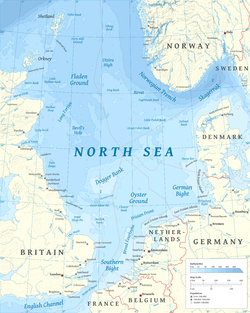| Action of 19 August 1916 | |||||||
|---|---|---|---|---|---|---|---|
| Part of the First World War | |||||||
 Map of the North Sea | |||||||
| |||||||
| Belligerents | |||||||
|
|
| ||||||
| Commanders and leaders | |||||||
|
|
| ||||||
| Strength | |||||||
|
29 battleships 6 battlecruisers 5 armoured cruisers 26 light cruisers 70 destroyers 1 minelayer 1 seaplane carrier 1 submarine |
18 battleships 2 battlecruisers 7 light cruisers 56 torpedo boats 2 Zeppelins 3 submarines | ||||||
| Casualties and losses | |||||||
|
39 killed 2 light cruisers sunk | 1 battleship damaged | ||||||
Location in the North Sea | |||||||
The action of 19 August 1916 was one of two attempts in 1916 by the German High Seas Fleet to engage elements of the British Grand Fleet, following the mixed results of the Battle of Jutland, during the First World War. The lesson of Jutland for Germany had been the vital need for reconnaissance, to avoid the unexpected arrival of the Grand Fleet during a raid. Four Zeppelins were sent to scout the North Sea between Scotland and Norway for signs of British ships and four more scouted immediately ahead of German ships. Twenty-four German submarines kept watch off the English coast, in the southern North Sea and off the Dogger Bank.[1]
- ^ Roskill 1980, pp. 196–197.
